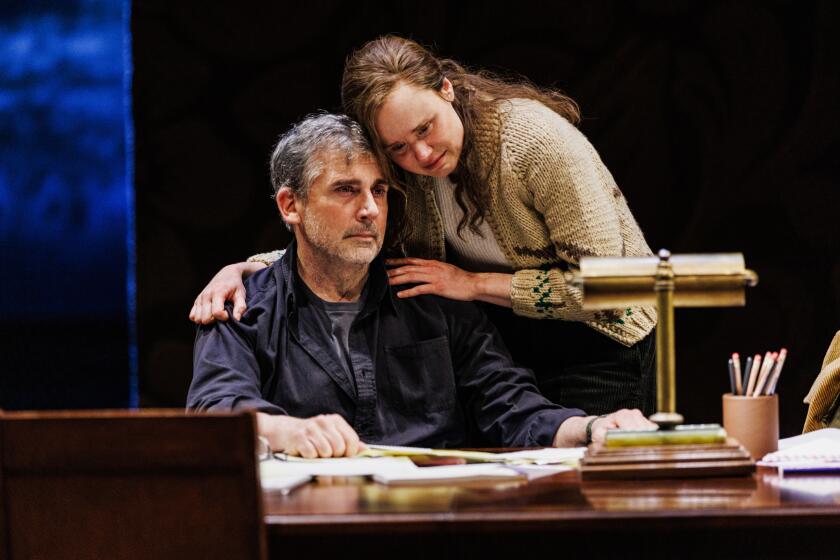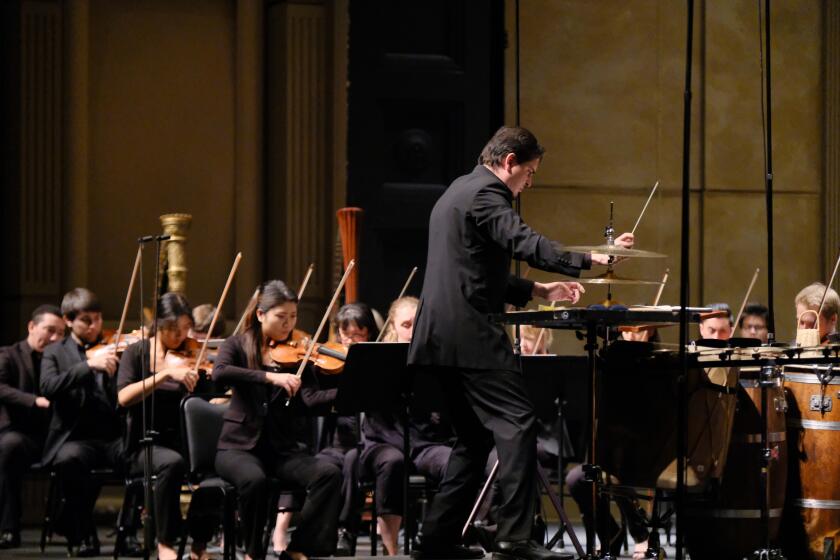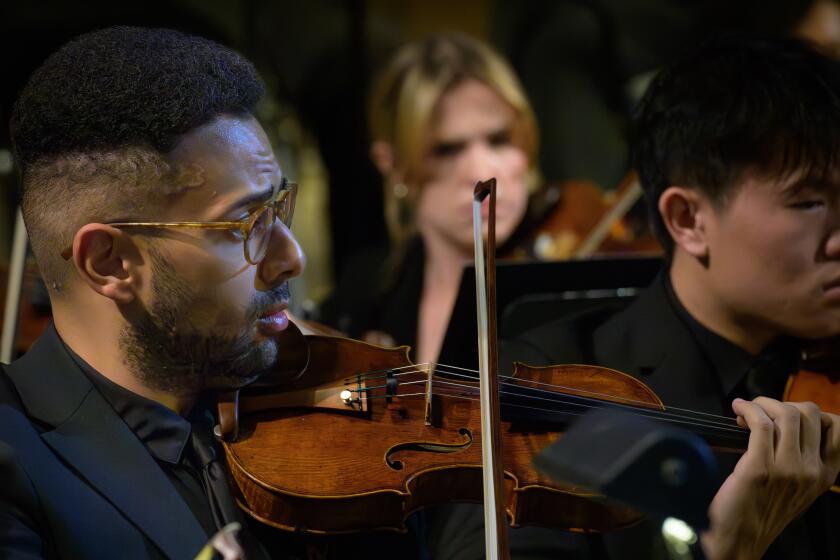Civic and Mural Virtues
Edward Millman painted for two years in the windowless foyer of the Lucy Flower Career Academy, applying dark earth tones to wet plaster to create his sullen 54-foot-long fresco “Outstanding American Women.” One year later, the Chicago Board of Education ordered it whitewashed.
The mural depicting Susan B. Anthony, Harriet Tubman and Clara Barton, among others, comforting the sick, righting the wrongs of men and keeping them from warring, was “subversive,” the all-male board declared in 1941, “misery laden.”
For more than half a century, Millman’s work lay buried beneath coats of greasy white paint as maintenance workers unknowingly drove nails into the fresco to hang school placards and cut holes for electrical outlets.
The painting is once again the prize of the rundown high school, restored along with 436 other murals from the early 20th century Progressive era and President Franklin D. Roosevelt’s Works Progress Administration in Chicago public schools. The sweeping effort has rescued an entire epoch of valuable but mostly forgotten artwork.
The preservation program is serving as a reminder to thousands here of the surprising delights of public, and publicly funded, art, with many of the murals created by renowned artists of the period.
The conservationists, teachers and current Board of Education hope it also serves as timely encouragement to other cities that saving the thousands of Progressive and WPA works around the country is financially feasible during a time of cost-cutting in the arts.
With conservators dropping their fees and the Board of Education backing the project, the price to conserve the collection -- some pieces 80 feet long and badly water damaged, some so cracked they required hundreds of hours of restoration work -- has come to about $2 million.
In Los Angeles, decades of delays and bureaucratic battles over Mexican painter David Alfaro Siqueiros’ 80-foot-long “America Tropical” have driven the cost of conserving and displaying the single piece to $4.5 million. The mural is scheduled to be unveiled in the spring of 2004 on Olvera Street.
Across the country, numerous works from the heyday of federally funded art have been restored in schools, post offices and other public buildings. The programs have typically been small, however, using money from bake sales and carwashes to restore one or two pieces out of a collection of dozens or hundreds.
“Nothing quite like this had been done before,” said Heather Becker, an artist and the primary force behind the eight-year effort. “I hope this convinces others to conserve their public art.
“There was an entire museum-size mural collection in the city that had, over the decades, simply been forgotten,” Becker added as she stood recently beneath “Outstanding American Women.” “We have preserved every one we could find. And many, like this one, are terrific pieces.”
*
Flora Doody took note of the murals the first day she walked into Lane Technical High School in 1984.
“I was bumping into students in the hall because I was looking up at these murals,” the special education teacher said. “But I was the only one looking up.”
The larger-than-life scenes of men working the docks and kings issuing decrees had been there forever, as far as anyone knew. Most were so dim, mottled by decades of soot stains and weathering, covered with graffiti, gouged and torn, that they had become little more than unattractive paneling.
A decade passed as Doody launched a new special education program. But when a 14-foot-long mural that would later be revealed as one of the earliest in Chicago, from 1909, began tearing away from its hallway frame, she called an acquaintance from the Chicago Art Institute, asking Barry Bauman to take a look to see whether he might be able to save the work.
Bauman, who had since started his own firm, the Chicago Conservation Center, visited the school, expecting a piece of amateur schoolhouse art.
“It was all a dingy mess,” Bauman said. “But once I started really looking, it was just incredible. I said, ‘Flora, you’ve got a lot more going on here than one torn mural.’ ”
Lane, it happened, was home to 66 murals, including a rare piece by respected African American artist William Edouard Scott, now on display at the Art Institute, 40 murals created for the 1933 Chicago World’s Fair, and two frescoes -- works created by painting on wet plaster so that the pigments become part of the structure. Just as Michelangelo created his masterpiece on the ceiling of the Sistine Chapel, the fresco artists at Lane worked on very small portions at a time, impelled to paint before the plaster dried.
If there were 66 murals at one school, and 600 public schools in Chicago, certainly more works were waiting to be discovered and preserved.
Bauman asked Becker, vice president of the Chicago Conservation Center, to see what else she could find. A historian as well as an artist, Becker began a years-long hunt for paintings, combing through thousands of decades-old documents to try to determine which schools had murals, then on which wall or ceiling in which classroom they hung. She dug around in boiler rooms and stalked the hallways with a scalpel to peel back top-coat paint and see what lay beneath.
An engineer at one school had pulled three whitewashed canvas murals from a Dumpster 15 years before and had kept them rolled up in the basement, just in case. At another school, where a lead-abatement program was underway, Becker discovered a series of paintings that would have been destroyed in a matter of weeks.
At yet another, “there was an electrical box and I noticed paint chipping away around it,” Becker said. “I took a scalpel and chipped away some more and there were [Florian] Durzynski’s brush strokes. You learn their styles so well I knew immediately it was him.”
Federal art funding began in earnest shortly after the turn of the century, when President Theodore Roosevelt’s progressive policies began addressing the growing plight of the poor. The funding waned during succeeding administrations, but grew again dramatically beginning in 1935 when President Franklin D. Roosevelt added artists to the list of the unemployed he was attempting to send back to work during the Depression.
Under the auspices of the WPA, the government commissioned thousands of works of art in public spaces, from murals to statues to wood carvings, many of them by prominent artists. Those who worked in Chicago schools included such nationally recognized artists as Millman, Durzynski, Edgar Britton, Mitchell Siporin and Rudolph Weisenborn, the last of whom was “Chicago’s Picasso,” who helped pave the rough road for modern art in the conservative Midwestern city.
Some of the other artists enjoyed such little name recognition that the conservators have been unable to learn anything about their lives or careers. And some of the murals are simple both in concept and execution, the works of people who would never make much of a living in the art world.
Many, however, “were done by very fine artists,” Bauman said, “some of them extraordinary artists, who were starving.”
As art for the masses, or “Art for the People” -- the title of a new book on the project by Becker -- murals were among the most common forms.
Many of the murals Becker began turning up reflect their time and the programs that funded them. Most of them are painted on canvas and glued to the wall. They depict steelworkers and railroaders building a grand nation and pioneers heading west, but also coal miners in misery, blacks fighting their way out of slavery, unionists and reformers in left-leaning political pieces such as the one whitewashed at Lucy Flower.
Many were, until recently, ripped, covered with graffiti, painted over, cut up or so cracked that they forced conservators to use a syringe to make thousands of injections of adhesive behind the flakes.
“They were so stained, it was like you were looking through dark glasses,” said Lane Tech librarian Ann Tanner, nodding to what is now one of the brightest pieces in the collection, a 15-foot-high depiction of Robin Hood. “You couldn’t really tell what they were, so no one paid attention.”
With only a few thousand dollars in private grants, Becker and Bauman -- who will give the keynote addresses in Los Angeles at a Getty Center murals symposium in May -- along with other early enthusiasts, needed a centerpiece to convince the city and the school board that restoration and conservation of decades-old damaged art was worth an investment.
Millman’s abused fresco would be that piece.
Principal Dorothy Williams had learned years before that a supposedly spectacular mural had been painted over, but years of inquiries brought no help and lots of advisors who said that whatever was under that nasty paint could never be restored.
Bauman disagreed, but nonetheless tested removing its covering of the white oil-based paint. He eventually concocted a poultice paste of 60% sodium hydroxide and 40% magnesium hydroxide.
Applying the mix to a small corner of the mural, numerous tests revealed that, if left in place for 85 minutes, the paste would swell and soften the whitewash without damaging the fresco, and conservators using palette knives and other implements could remove the top layers.
After hundreds of hours of painstaking work, first removing the whitewash and then repairing holes with marble dust and rabbit-skin glue, Millman’s fresco was reborn.
The criticisms of the school board in 1941 are not entirely inaccurate. The restored piece is laden with misery, and if not subversive, it certainly pushed hard to the left of the politics of the time. It also is a wonder to behold in a school surrounded by drug-dealing and violence.
Divided by looming stone-like structures and ethereal walls, the mural depicts eight women, beginning with the school’s namesake, Lucy Flower, teaching girls, and ending with American Red Cross founder Clara Barton, as well as two allegorical scenes, one of women working in a sweatshop and the final panel of a woman pulling up a man of peace while pushing down a warrior in a World War I-era gas mask.
A student of renowned Mexican muralist Diego Rivera, Millman created a nuanced work about the travails of workers and minorities, with women seeming to offer the best hope for a way out of his grim world.
The restored mural was unveiled in 1997, and its raw power prompted city and school officials to fund the conservation of every remaining mural in every school, including the city’s only known Modernist mural, Weisenborn’s “Contemporary Chicago.”
Four children sat on a kid-sized bench one recent day beneath the 23-foot-long, 7-foot-high cubist work at Louis Nettelhorst Elementary School. They were paying no attention to the art above them. Their heads were down. They were in trouble.
Indeed, once the conservators disappeared from their schools and the initial lessons about the restoration ended, few students have paid much attention to the murals, Becker acknowledged. But that’s not the point.
“They learned a little bit. They know they have important art on their walls,” she said. “It affects them. They don’t have to look at them constantly. They are still changed.”
More to Read
The biggest entertainment stories
Get our big stories about Hollywood, film, television, music, arts, culture and more right in your inbox as soon as they publish.
You may occasionally receive promotional content from the Los Angeles Times.






